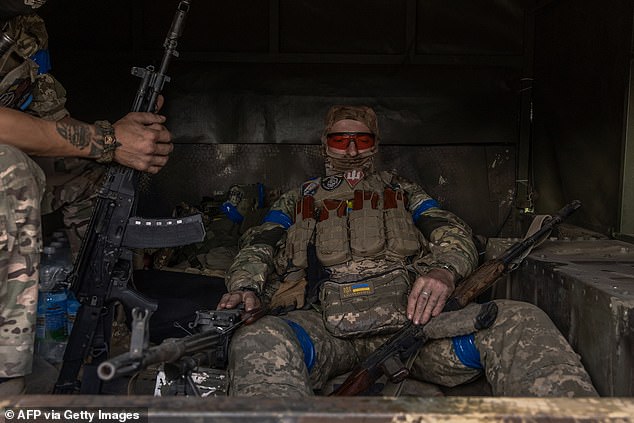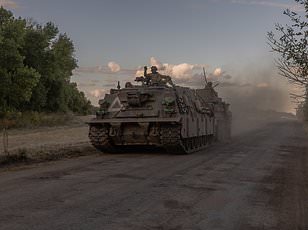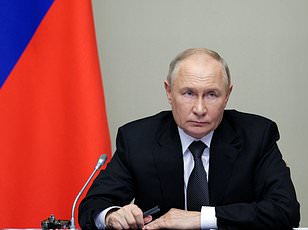EXCLUSIVEHas Zelensky altered the course of the war - or fatally poked the Russian bear? Experts reveal just what Ukraine hopes to achieve with Kursk offensive and whether it could prove a tactical masterstroke
- MailOnline examines the invasion so far and assesses what may come next
On Tuesday, August 6, around 1,000 brave Ukrainian soldiers supported by a few tanks launched what seemed like a reckless at best - and catastrophic at worst - incursion into Russia's Kursk region.
Within 48 hours of the first reports of the border breach, Russia's stonefaced army chief Valery Gerasimov - who reportedly dismissed intelligence reports indicating a Ukrainian troop buildup along the border two weeks prior - declared the invasion had been stopped in its tracks.
Now, one week later, not only have Kyiv's soldiers made a fool of Gerasimov, but AFU commander Oleksandr Syrskyi claims his troops have seized one square kilometre of territory for each soldier that poured across the border - and that the initial invasion force has been reinforced by thousands more troops backed by Western armour.
With the offensive still grinding on, a Ukrainian foreign ministry spokesperson declared today that 'as long as Putin continues the war, he will receive such responses from Ukraine'.
That defiant statement came hours after his president Volodymyr Zelensky told the world that 'war was coming home' to Russia and vowed to 'kill the Russian terrorists where they are and where they launch their strikes from'.
MailOnline spoke to several experts to examine the invasion so far, explain what its goals might be, and predict how long the valiant Ukrainian units tasked with launching the first invasion of Russia since World War II can hope to hold out.




'Russia must be forced into peace if Putin wants to continue waging war so badly... This always happens to those who despise people and any rules - Russia brought war to others, and now it is coming home,' Zelensky said stoically in his latest address

Ukrainian servicemen operate an armoured military vehicle in the Sumy region, near the border with Russia, on August 12, 2024

This photograph shows a road sign showing the distance to the Russian town of Kursk next to the destroyed border crossing point with Russia, in the Sumy region, on August 13, 2024
How did the invasion unfold and how many Ukrainian troops are now in Russia?
In the early hours of Tuesday, August 6, a contingent of Ukrainian troops launched their first incursion across the border from the Sumy region into Russia's Kursk oblast.
They have since managed to advance up to 20 miles in some directions, have captured dozens of towns and settlements, and have as of this morning reportedly seized Sudzha - a strategic town that is also a key transit hub for Russian gas flowing into Ukraine.
More than 120,000 Russian citizens have been forced to flee their homes amid widespread regional evacuations since last Tuesday, while 12 civilians are said to have died.
Russia has seen previous small-scale incursions into its territory since it invaded Ukraine in February 2022, but the foray into the Kursk region marked the largest attack on Russian soil since World War II.
It was also the first time the Ukrainian army proper had spearheaded an incursion, rather than pro-Ukraine Russian fighters that had defected - and the first offensive in Russia to be acknowledged by Zelensky.
Matthew Savill, the Director of Military Sciences at the RUSI think tank, told MailOnline there could be as many as 10,000 Ukrainian troops now in Russia.
'There's evidence of Ukrainian forces from at least four different brigades - 22nd and 88th Mechanised and 80th and 82nd Air Assault, and possibly more - now involved in the offensive in Kursk.
'These brigades are using Western-provided equipment like infantry fighting vehicles as well as Soviet-era tanks.
'It's hard to judge numbers, but it might be enough for around a division - perhaps 10,000 - given the spread of fighting now underway.
'But we should be very cautious about determining exact size, because units are being rotated, and the presence of elements doesn't tell us the whole unit has been deployed.
'That ambiguity suits the Ukrainians.'
Savill did however challenge the assertion that Ukraine had seized up to 1,000 square kilometres of Russian territory.
'The total area covered by the incursion appears to be around 400 square kilometres, but we don't know what is controlled within this,' he said.
Dara Massicot, an analyst at the Carnegie Endowment for International Peace, added that the Ukrainian breakthrough was so effective because it exploited key gaps between various Russian commands in Kursk: border guards, Ministry of Defence forces and Chechen units that have been fighting on Russia's side in the war.

This photograph shows 'dragon's teeth' and other fortifications at the destroyed border crossing point with Russia, in the Sumy region, amid the Russian invasion of Ukraine

Ukrainian servicemen operate a Soviet-made T-72 tank in the Sumy region, near the border with Russia, on August 12, 2024, amid the Russian invasion of Ukraine

Ukrainian servicemen wait in a military vehicle to head for a combat mission, in the Sumy region, near the border with Russia, on August 13, 2024

Ukrainian soldier stands guard as he surveys a line of Russian POWs taken in Kursk

A Ukrainian soldier raises a Ukrainian flag in Guevo, Kursk Oblast, Russia released August 11, 2024 in this still image obtained from a social media video
What does Ukraine hope to achieve by invading Russia?
Most experts agree that Ukraine's incursion into Russia is a two-pronged tactic designed primarily to signal to its Western partners that its military is still a capable fighting force, while also seeking to put Kyiv in a more favourable bargaining position in the event of ceasefire talks ahead of the US presidential election in November.
That analysis was supported by a statement from a Ukrainian foreign ministry spokesperson, who today told reporters in Kyiv: 'The sooner Russia agrees to restore a just peace, the sooner Ukrainian raids on Russian territory will stop.'
The spokesperson did however add that: 'As long as Putin continues the war, he will receive such responses from Ukraine,' suggesting Kyiv could seek to extend the offensive indefinitely.
He also said that Russia had launched more than 2,000 strikes from the Kursk region in recent months using anti-aircraft missiles, barrel artillery, mortars, drones, 255 glide bombs and more than 100 missiles, and explained that 'the purpose of this operation is to preserve the lives of our children, to protect the territory of Ukraine from Russian strikes'.
Meanwhile, Ukrainian soldiers told reporters this week that the offensive could help to draw Russian resources away from other key battles on Ukrainian soil, giving defenders time to regroup, re-equip and hopefully regain the initiative after months of grinding, bloody conflict.
Retired US Army Brigadier General and former US Defence Attaché in Moscow Kevin Ryan said: 'Zelensky's goals with the incursion into Russian territory are becoming clearer with time.
'It appears that the attacking force, which is composed of some of Ukraine's best units, is intent on achieving real military objectives and possibly holding some of the ground they take...
'(Russian reports claim) Ukrainian forces are digging in along parts of the new front. This would indicate an intent to hold the territory that Ukraine has seized in the Kursk/Belgorod region.'
Jacob Parakilas, research leader for Defence Strategy, Policy and Capabilities at the thinktank RAND Europe, said: 'The Ukrainians have been understandably cagey about what their intended goals are, but there are a few things they could be seeking to simultaneously accomplish.
'Pushing into Russian territory upsets the narrative that Ukraine is on the defensive and embarrasses Putin.
'On a more tactical level, it forces Russia to divert its own forces towards territorial defence rather than offence – although thus far it seems as though Russian forces are continuing to push forward on Ukrainian territory.
'There are various pieces of strategic infrastructure that Ukraine might be seeking to capture or disable, notably the gas transfer station in Sudzha.'

This photograph shows the destroyed border crossing point with Russia, in the Sumy region, on August 13, 2024, amid the Russian invasion of Ukraine

Ukrainian servicemen operate an armoured military vehicle in the Sumy region, near the border with Russia, on August 12, 2024, amid the Russian invasion of Ukraine

Russia last week suffered one of its most crushing blows of the war as hundreds of troops were reportedly killed when a military convoy was hit by Ukrainian HIMARS missiles in Kursk

A man reacts while standing next to burnt-out remains of cars in the courtyard of a multi-storey residential building, which according to local authorities was hit by debris from a destroyed Ukrainian missile, in the course of Russia-Ukraine conflict in Kursk, Russia August 11, 2024
RUSI's Savill agreed with the above comments but posited the offensive could have some additional aims not yet revealed by Ukrainian officials.
'It's also about boosting Ukrainian morale after months on the defensive. This seems to be the case in the north - though could easily turn if they take losses which are hard to replace.
'It could also be a diversion, or linked to other, undeclared operations; for example, an advance that threatens the supply lines for Russian troops that crossed the border near Kharkiv, and intends to cause the collapse of those pockets of Russian forces over the border.
'This is a risky operation... but the Ukrainians have shown themselves to be resourceful. They appear to have some air defences with them and have successfully used drones to attack Russian helicopters in the air.
'Moreover, the Russians have been severely embarrassed and the loss of territory and evacuation of civilians will play poorly back in Russia as evidence they ''can't defend themselves'' - especially alongside continued Ukrainian drone attacks as deep strikes.'
How is Russia responding?
Vladimir Putin on Monday lambasted the incursion as the Western plot in its war with Russia, using Ukrainian soldiers to do their dirty work.
'It is now clear why the Kyiv regime refused our proposals to return to a peaceful settlement plan,' he declared.
'To all appearances, the enemy, with the help of its Western masters, is doing their will. By the hands of the Ukrainians, the West is at war with us.
'But what kind of negotiations can we even talk about with people who indiscriminately strike at civilians, at civilian infrastructure, or try to create threats to nuclear power facilities?' he asked - comments that will undoubtedly be ridiculed in Kyiv and the West given the scale of the destruction wrought by Russian missiles, drones and soldiers in towns and cities across Ukraine.
RUSI's Savill said: 'The Russians seem to have been caught by surprise, or at least not prepared.
'Their initial force of border guards and FSB seems to have been overwhelmed, early public messages that the attack had been ''repulsed'' have been deleted, and a state of emergency has been announced in several oblasts,' he said, adding that tens of thousands of civilians were evacuated with tens of thousands more choosing to flee.
He added: 'Over the weekend, it seems like more Russian forces, including some pulled from inside Ukraine, have started arriving and may have now halted further Ukrainian advances, but it's not been a particularly impressive response yet.'
A slew of video footage published late last week showed how homes in various settlements had come under attack from Ukrainian drones and artillery fire, while various Russian warbloggers said hundreds of their troops had perished in a brutal HIMARS strike on a convoy in the Rylsky district of Kursk.

Seeking to blame the incursion on Ukraine's allies in the West, the humiliated Russian President cursed Kyiv's troops for refusing to 'return to a peaceful settlement plan' before ironically condemning them for 'intimidating Russian society' and 'targeting civilians'

This photo taken from video released by Russian Defence Ministry press service on Monday, Aug. 12, 2024, shows Russian military vehicle boarding a lowboy for transfer to Kursk region

Ukrainian servicemen drive Soviet-made T-64 tanks in the Sumy region, near the border with Russia, on August 11, 2024

People evacuated from a fighting between Russian and Ukrainian forces queue to receive humanitarian aid at a distribution centre in Kursk, Russia, Monday, Aug. 12, 2024

Russian forces launch an unmanned aerial vehicle (UAV) attack, targeting the tank of Ukrainian Armed Forces at the border area near Kursk Oblast, Russia on August 12, 2024
As of this morning, however, Moscow's forces appear to have begun mounting a more robust defence of their territory.
Army units, fresh reserves, army aircraft, drone teams and artillery forces have now been funnelled into the conflict to stop Ukrainian armoured mobile groups from moving deeper into Russia.
A Russian defence ministry statement issued today said that those units had managed to halt the Ukrainian offensive near the Kursk settlements of Obshchy Kolodez, Snagost, Kauchuk and Alexeyevsky - though those reports are yet to be corroborated.
It remains to be seen just how many troops and resources the Kremlin's military chiefs are willing to throw in to defend and retake land in Kursk.
How long could Ukraine's offensive in Russia last?
Russian military blogger Vladislav Shurygin last week encapsulated the efficacy of Ukraine's surprise offensive in a lengthy observation.
He wrote that Ukraine had 'very skilfully and accurately chosen a different strategy - taking advantage of the bureaucratic rigidity and sluggishness of the Russian management system, to exhaust Russia with continuous unexpected strikes on sensitive infrastructure and the civilian population, provoking discontent, disappointment and apathy.'
But analysts are split on whether the offensive will endure, with many warning the Ukrainians would be sorely outmatched once Russia's disorganised military command is able to mobilise the requisite resources.
Brig. Gen. Ryan said: 'If, in going to the defence Ukraine can turn this part of the front on Russian soil into the same kind of positional war that has evolved along the rest of the front in eastern Ukraine, Kyiv's forces could hold this ground for weeks or even months.'
Other experts added that Russia could feasibly repel the invasion in short order, but stressed they would likely need to withdraw troops from frontline positions in Ukraine to do so.
RUSI's Savill was more sceptical that Ukraine could - or would even want to - maintain their offensive over the long term.
'Much will depend on the ambition around any consolidation and whether this is intended to play into negotiations - and therefore how long they try to hold on,' he said.
'While the Ukrainians have reversed the public narrative about being on the defensive, it seems unlikely they would want to sustain a large incursion for months; they will have a decision to make about the best time to trade in the ground they have captured, and to what end...
'Media reporting over the weekend suggested that the Ukrainians had deployed some of their most effective mechanised units, and pulled troops from the east because they were at a higher level of readiness. That could result in a short-term gain, for long-term disadvantage.'
RAND Europe's Parakilas concluded that the long-term success of Kyiv's offensive in Kursk is largely dependent on Russia's willingness to sacrifice its gains in eastern Ukraine, particularly as summer rapidly gives way to autumn with cold conditions around the corner.
'The extent to which the Ukrainian offensive in Kursk will last depends heavily on the forces that Russia is willing to commit to retaking its own territory.
'Thus far it seems as though the bulk of the forces that have been engaging Ukrainian troops on Russian territory have been reserve and paramilitary units, which have apparently been unable to retake the territory lost to Kyiv's troops.
'If Russia is willing to pull more experienced and capable formations out of Ukraine and put them to the task, they would increase their odds of reversing the Ukrainian gains.
'But that would also force them to slow the pace of their own offensive on key strategic positions in eastern Ukraine in the key window of time remaining time before colder weather makes offensive operations more difficult.'





































































































































































































































































































































































